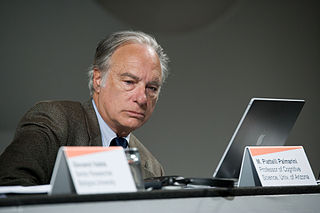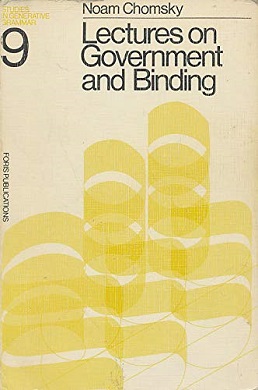The following outline is provided as an overview and topical guide to linguistics:
In linguistics, transformational grammar (TG) or transformational-generative grammar (TGG) is part of the theory of generative grammar, especially of natural languages. It considers grammar to be a system of rules that generate exactly those combinations of words that form grammatical sentences in a given language and involves the use of defined operations to produce new sentences from existing ones.
Lexical semantics, as a subfield of linguistic semantics, is the study of word meanings. It includes the study of how words structure their meaning, how they act in grammar and compositionality, and the relationships between the distinct senses and uses of a word.
The concept of communicative competence, as developed in linguistics, originated in response to perceived inadequacy of the notion of linguistic competence. That is, communicative competence encompasses a language user's grammatical knowledge of syntax, morphology, phonology and the like, but reconceives this knowledge as a functional, social understanding of how and when to use utterances appropriately.

Generative grammar, or generativism, is a linguistic theory that regards linguistics as the study of a hypothesised innate grammatical structure. It is a biological or biologistic modification of earlier structuralist theories of linguistics, deriving from logical syntax and glossematics. Generative grammar considers grammar as a system of rules that generates exactly those combinations of words that form grammatical sentences in a given language. It is a system of explicit rules that may apply repeatedly to generate an indefinite number of sentences which can be as long as one wants them to be. The difference from structural and functional models is that the object is base-generated within the verb phrase in generative grammar. This purportedly cognitive structure is thought of as being a part of a universal grammar, a syntactic structure which is caused by a genetic mutation in humans.

Ray Jackendoff is an American linguist. He is professor of philosophy, Seth Merrin Chair in the Humanities and, with Daniel Dennett, co-director of the Center for Cognitive Studies at Tufts University. He has always straddled the boundary between generative linguistics and cognitive linguistics, committed to both the existence of an innate universal grammar and to giving an account of language that is consistent with the current understanding of the human mind and cognition.
Theta roles are the names of the participant roles associated with a predicate: the predicate may be a verb, an adjective, a preposition, or a noun. If an object is in motion or in a steady state as the speakers perceives the state, or it is the topic of discussion, it is called a theme. The participant is usually said to be an argument of the predicate. In generative grammar, a theta role or θ-role is the formal device for representing syntactic argument structure—the number and type of noun phrases—required syntactically by a particular verb. For example, the verb put requires three arguments.
Conceptual semantics is a framework for semantic analysis developed mainly by Ray Jackendoff in 1976. Its aim is to provide a characterization of the conceptual elements by which a person understands words and sentences, and thus to provide an explanatory semantic representation. Explanatory in this sense refers to the ability of a given linguistic theory to describe how a component of language is acquired by a child.
In linguistics and social sciences, markedness is the state of standing out as nontypical or divergent as opposed to regular or common. In a marked–unmarked relation, one term of an opposition is the broader, dominant one. The dominant default or minimum-effort form is known as unmarked; the other, secondary one is marked. In other words, markedness involves the characterization of a "normal" linguistic unit against one or more of its possible "irregular" forms.

Biolinguistics can be defined as the study of biology and the evolution of language. It is highly interdisciplinary as it is related to various fields such as biology, linguistics, psychology, anthropology, mathematics, and neurolinguistics to explain the formation of language. It seeks to yield a framework by which we can understand the fundamentals of the faculty of language. This field was first introduced by Massimo Piattelli-Palmarini, professor of Linguistics and Cognitive Science at the University of Arizona. It was first introduced in 1971, at an international meeting at the Massachusetts Institute of Technology (MIT).
The term linguistic performance was used by Noam Chomsky in 1960 to describe "the actual use of language in concrete situations". It is used to describe both the production, sometimes called parole, as well as the comprehension of language. Performance is defined in opposition to "competence"; the latter describes the mental knowledge that a speaker or listener has of language.

Joan Lea Bybee is an American linguist and professor emerita at the University of New Mexico. Much of her work concerns grammaticalization, stochastics, modality, morphology, and phonology. Bybee is best known for proposing the theory of usage-based phonology and for her contributions to cognitive and historical linguistics.
In linguistics, well-formedness is the quality of a clause, word, or other linguistic element that conforms to the grammar of the language of which it is a part. Well-formed words or phrases are grammatical, meaning they obey all relevant rules of grammar. In contrast, a form that violates some grammar rule is ill-formed and does not constitute part of the language.
Functional grammar (FG) and functional discourse grammar (FDG) are grammar models and theories motivated by functional theories of grammar. These theories explain how linguistic utterances are shaped, based on the goals and knowledge of natural language users. In doing so, it contrasts with Chomskyan transformational grammar. Functional discourse grammar has been developed as a successor to functional grammar, attempting to be more psychologically and pragmatically adequate than functional grammar.

Aspects of the Theory of Syntax is a book on linguistics written by American linguist Noam Chomsky, first published in 1965. In Aspects, Chomsky presented a deeper, more extensive reformulation of transformational generative grammar (TGG), a new kind of syntactic theory that he had introduced in the 1950s with the publication of his first book, Syntactic Structures. Aspects is widely considered to be the foundational document and a proper book-length articulation of Chomskyan theoretical framework of linguistics. It presented Chomsky's epistemological assumptions with a view to establishing linguistic theory-making as a formal discipline comparable to physical sciences, i.e. a domain of inquiry well-defined in its nature and scope. From a philosophical perspective, it directed mainstream linguistic research away from behaviorism, constructivism, empiricism and structuralism and towards mentalism, nativism, rationalism and generativism, respectively, taking as its main object of study the abstract, inner workings of the human mind related to language acquisition and production.

Lectures on Government and Binding: The Pisa Lectures (LGB) is a book by the linguist Noam Chomsky, published in 1981. It is based on the lectures Chomsky gave at the GLOW conference and workshop held at the Scuola Normale Superiore in Pisa, Italy, in 1979. In this book, Chomsky presented his government and binding theory of syntax. It had great influence on the syntactic research in early 1980s, especially among the linguists working within the transformational grammar framework.
In linguistics, transformational syntax is a derivational approach to syntax that developed from the extended standard theory of generative grammar originally proposed by Noam Chomsky in his books Syntactic Structures and Aspects of the Theory of Syntax. It emerged from a need to improve on approaches to grammar in structural linguistics.
The Integrational theory of language is the general theory of language that has been developed within the general linguistic approach of integrational linguistics.
In linguistics, the autonomy of syntax is the assumption that syntax is arbitrary and self-contained with respect to meaning, semantics, pragmatics, discourse function, and other factors external to language. The autonomy of syntax is advocated by linguistic formalists, and in particular by generative linguistics, whose approaches have hence been called autonomist linguistics.
Michael K. Brame was an American linguist known for his contributions to the field. He served as a professor at the University of Washington and was the founding editor of the peer-reviewed research journal, Linguistic Analysis. Brame's work focused on the development of recursive categorical syntax, also referred to as algebraic syntax, which integrated principles from algebra and category theory to analyze sentence structure and linguistic relationships. His framework challenged conventional transformational grammar by advocating for a lexicon-centered approach and emphasizing the connections between words and phrases. Additionally, Brame collaborated with his wife on research investigating the identity of the author behind the name "William Shakespeare", resulting in several publications. His legacy is marked by his impactful contributions to linguistic theory and his exploration of language intricacies.





